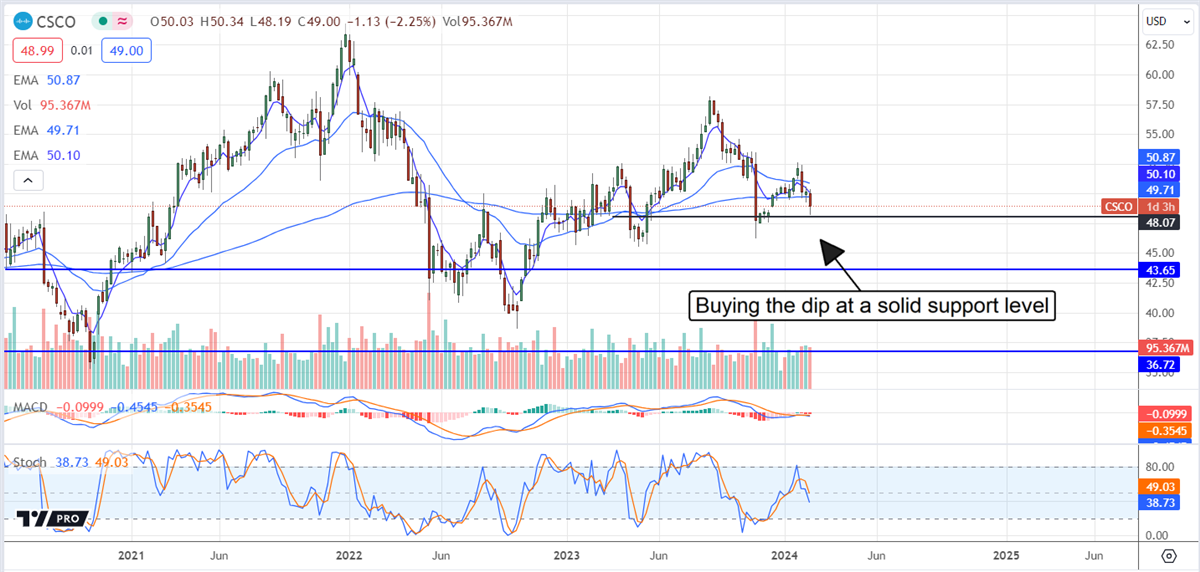Cisco Systems unveiled a strong FQ2 report, surpassing expectations. Despite this positive performance, a lackluster guidance left investors feeling disheartened. Nevertheless, amidst the discouraging outlook, a particular breed of investors emerged, displaying an appetite for the company’s stock. These astute, long-term focused income investors are the architects behind the recent spike in Cisco’s stock purchases. Despite the gloomy financials, Cisco remains a solid generator of cash flow, boasting improved margins, and has the financial wherewithal to fund lucrative dividends and engage in share buybacks.
Trading at an attractive 13.5X earnings, Cisco presents itself as one of the most cost-effective options within the tech stock sphere. Moreover, it provides investors with an above-average yield, contributing to the alluring appeal of the stock. Cisco’s dividend offering is one of the most attractive in the tech landscape, boasting a yield north of 3.0%, amidst near 1-year low stock prices. Despite a somewhat clouded earnings outlook as compared to analyst forecasts, the company’s financial strength allows for substantial capital returns. In fact, the latest guidance positions the company’s 2024 payout ratio around 44%, which includes a newly announced 3% increase. Furthermore, the company’s balance sheet remains robust, with no concerning indicators and an adept handle on net cash and leverage.
The solid cash flow also facilitates significant share repurchases. For instance, in Q2 alone, Cisco repurchased $1.3 billion, leading to an almost 1% reduction in YTD average share count. With $8.4 billion remaining under the current authorization and no expiration date, representing about 4% of the market cap, future repurchases are anticipated across F2024 and into F2025.
The Transformation to a Subscription Model
In FQ2, Cisco Systems encountered a challenging quarter, reporting a revenue of $12.8 billion, signifying a 5.9% decline from the preceding year. Although the revenue exceeded consensus estimates, the robust performance was confined to a few select areas. Notably, while Product revenue plummeted by 9%, primarily due to a 12% dip in Networking, the company’s core business, Services growth offset some of the decline. However, all geographical regions exhibited weakness, with the Asia-Pacific region suffering the most substantial blow, registering a 12% decline. In contrast, within the Services segment, subscriptions witnessed a 5% surge, while ARR soared by 6%, alongside a 12% rise in the remaining performance obligation.
A silver lining came in the form of favorable margin news. Cisco managed to expand its gross margin across all segments on both GAAP and adjusted bases, while effectively controlling costs. Remarkably, the SG&A remained stagnant, thereby enhancing the company’s operating and income margins. As a result, the adjusted EPS came in at $0.87, falling a mere 1% but surpassing expectations by $0.03.
However, the market downturn stemmed from the company’s uninspiring guidance for Q3 and the full year, indicating revenue and earnings figures below the consensus. Notwithstanding, analysts opine that this weakness is already factored into the market. Furthermore, with promising margins and an anticipated upturn in business conditions in Q4, the 24 analysts tracked by Marketbeat maintain a Hold rating, projecting a 17% advancement. Post-release, Cisco witnessed several reiterated ratings, an amplified target, and an initiation of a buy-equivalent from Wells Fargo.
The Steady Trajectory of Cisco Systems
Unquestionably, the trajectory of institutional activity serves as a telling indicator. In Q4 2023, a downswing in activity aligned with a dip in share prices, reflecting a bearish sentiment which abruptly transitioned to bullishness in Q1 2024. This turnaround coincided with the firm support at a crucial level, hinting at potential rebound later in the year. Evidently, institutions collectively own around 72% of this high-yield value player, gradually reinforcing their position over the years.
Technically, the stock is indicating robust support around $48 and may experience a resurgence in the foreseeable future. Nevertheless, a sustained rally seems improbable until later in the year. Resistance levels in the vicinity of $50 and $55 are anticipated to curb gains, locking the stock within a bounded range until a positive catalyst emerges. In the interim, investors can rely on Cisco’s consistent dividends and repurchases, continually augmenting the value within their portfolios.

Original Post
